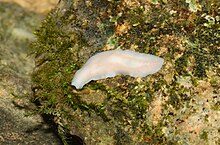Dendrocoelidae
| Dendrocoelidae | |
|---|---|

| |
| Dendrocoelum cavaticum | |
| Scientific classification | |
| Domain: | Eukaryota |
| Kingdom: | Animalia |
| Phylum: | Platyhelminthes |
| Order: | Tricladida |
| Superfamily: | Planarioidea |
| Family: | Dendrocoelidae Hallez, 1892 |
| Genera | |
Dendrocoelidae is a family of freshwater tricladida flatworms that has a holarctic distribution.[1]
The largest freshwater triclad known belongs to this family, it's up to 40 cm in length and inhabits the Lake Baikal.[2]
Description
The family Dendrocoelidae is characterized by an unusual arrangement of the muscle layers of the pharynx. While in most planarians the inner musculature of the pharynx is composed of two muscle layers, one circular and one longitudinal, in Dendrocoelidae the circular and longitudinal fibers are intermingled, forming a mixed layer.[1]
Dendrocoelidae is the sister group of Kenkiidae. Both families have an anterior adhesive organ, which is considered a synapomorphy of the group.[1]
Genera
Dendrocoelidae genera known are the following:[3]
Phylogeny
Phylogenetic supertree after Sluys et al., 2009:[3]
References
- ^ a b c Sluys, R.; Kawakatsu, M. (2006). "Towards a phylogenetic classification of dendrocoelid freshwater planarians (Platyhelminthes): A morphological and eclectic approach". Journal of Zoological Systematics and Evolutionary Research. 44 (4): 274. doi:10.1111/j.1439-0469.2006.00371.x.
- ^ Kozhov, M. 1963. Lake Baikal and Its Life. The Hague: W. Junk. vii + 344pp.
- ^ a b Sluys, R.; Kawakatsu, M.; Riutort, M.; Baguñà, J. (2009). "A new higher classification of planarian flatworms (Platyhelminthes, Tricladida)". Journal of Natural History. 43 (29–30): 1763–1777. doi:10.1080/00222930902741669.
